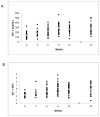Effects of GH in women with abdominal adiposity: a 6-month randomized, double-blind, placebo-controlled trial
- PMID: 22275471
- PMCID: PMC3651853
- DOI: 10.1530/EJE-11-1068
Effects of GH in women with abdominal adiposity: a 6-month randomized, double-blind, placebo-controlled trial
Abstract
Objective: Abdominal adiposity is associated with increased cardiovascular risk and decreased GH secretion. The objective of our study was to determine the effects of GH on body composition and cardiovascular risk markers in abdominally obese women.
Materials and methods: In this randomized, double-blind, placebo-controlled study, 79 obese premenopausal women received GH vs placebo for 6 months. Primary endpoints were i) total abdominal (total abdominal adipose tissue, TAT) fat by computed tomography (CT) (body composition) and ii) high-sensitivity C-reactive protein (hsCRP) (cardiovascular risk marker). Body composition was assessed by CT, dual-energy X-ray absorptiometry, and proton MR spectroscopy. Serum cardiovascular risk markers, carotid intima-media thickness, and endothelial function were measured.
Results: Mean 6-month GH dose was 1.7±0.1 mg/day, resulting in a mean IGF1 SDS increase from -1.7±0.08 to -0.1±0.3 in the GH group. GH administration decreased TAT and hsCRP compared with placebo. In addition, it increased thigh muscle mass and lean body mass and decreased subcutaneous abdominal and trunk fat, tissue plasminogen activator, apoB, and apoB/low-density lipoprotein compared with placebo. Visceral adipose tissue (VAT) decreased and intramyocellular lipid increased within the GH group. Six-month change in IGF1 levels was negatively associated with 6-month decrease in TAT and VAT. One subject had a 2 h glucose >200 mg/ml at 3 months; four subjects, three of whom were randomized to GH, had 2 h glucose levels >200 mg/ml at the end of the study.
Conclusion: GH administration in abdominally obese premenopausal women exerts beneficial effects on body composition and cardiovascular risk markers but is associated with a decrease in glucose tolerance in a minority of women.
Trial registration: ClinicalTrials.gov NCT00131378.
Conflict of interest statement
The authors have no conflict of interest to declare.
Figures






Similar articles
-
Effects of growth hormone administration for 6 months on bone turnover and bone marrow fat in obese premenopausal women.Bone. 2014 May;62:29-35. doi: 10.1016/j.bone.2014.01.022. Epub 2014 Feb 5. Bone. 2014. PMID: 24508386 Free PMC article. Clinical Trial.
-
Effects of GH on body composition and cardiovascular risk markers in young men with abdominal obesity.J Clin Endocrinol Metab. 2013 Sep;98(9):3864-72. doi: 10.1210/jc.2013-2063. Epub 2013 Jul 3. J Clin Endocrinol Metab. 2013. PMID: 23824419 Free PMC article. Clinical Trial.
-
Growth hormone decreases visceral fat and improves cardiovascular risk markers in women with hypopituitarism: a randomized, placebo-controlled study.J Clin Endocrinol Metab. 2008 Jun;93(6):2063-71. doi: 10.1210/jc.2007-2371. Epub 2008 Apr 1. J Clin Endocrinol Metab. 2008. PMID: 18381581 Free PMC article. Clinical Trial.
-
Visceral adiposity and inflammatory bowel disease.Int J Colorectal Dis. 2021 Nov;36(11):2305-2319. doi: 10.1007/s00384-021-03968-w. Epub 2021 Jun 9. Int J Colorectal Dis. 2021. PMID: 34104989 Review.
-
Effects of low dose versus high dose human growth hormone on body composition and lipids in adults with GH deficiency: a meta-analysis of placebo-controlled randomized trials.Pituitary. 2015 Jun;18(3):297-305. doi: 10.1007/s11102-014-0571-z. Pituitary. 2015. PMID: 24810900 Review.
Cited by
-
Association between muscle mass and insulin sensitivity independent of detrimental adipose depots in young adults with overweight/obesity.Int J Obes (Lond). 2020 Sep;44(9):1851-1858. doi: 10.1038/s41366-020-0590-y. Epub 2020 May 13. Int J Obes (Lond). 2020. PMID: 32404950 Free PMC article.
-
Effects of growth hormone administration for 6 months on bone turnover and bone marrow fat in obese premenopausal women.Bone. 2014 May;62:29-35. doi: 10.1016/j.bone.2014.01.022. Epub 2014 Feb 5. Bone. 2014. PMID: 24508386 Free PMC article. Clinical Trial.
-
The GH/IGF-1 axis in obesity: pathophysiology and therapeutic considerations.Nat Rev Endocrinol. 2013 Jun;9(6):346-56. doi: 10.1038/nrendo.2013.64. Epub 2013 Apr 9. Nat Rev Endocrinol. 2013. PMID: 23568441 Review.
-
Important Hormones Regulating Lipid Metabolism.Molecules. 2022 Oct 19;27(20):7052. doi: 10.3390/molecules27207052. Molecules. 2022. PMID: 36296646 Free PMC article. Review.
-
Maternal obesity programs reduced leptin signaling in the pituitary and altered GH/IGF1 axis function leading to increased adiposity in adult sheep offspring.PLoS One. 2017 Aug 3;12(8):e0181795. doi: 10.1371/journal.pone.0181795. eCollection 2017. PLoS One. 2017. PMID: 28771488 Free PMC article.
References
-
- Grundy SM. Obesity, metabolic syndrome, and coronary atherosclerosis. Circulation. 2002;105:2696–2698. - PubMed
-
- Rexrode KM, Carey VJ, Hennekens CH, Walters EE, Colditz GA, Stampfer MJ, Willett WC, Manson JE. Abdominal adiposity and coronary heart disease in women. Jama. 1998;280:1843–1848. - PubMed
-
- Pijl H, Langendonk JG, Burggraaf J, Frolich M, Cohen AF, Veldhuis JD, Meinders AE. Altered neuroregulation of GH secretion in viscerally obese premenopausal women. J Clin Endocrinol Metab. 2001;86:5509–5515. - PubMed
-
- Weaver JU, Monson JP, Noonan K, John WG, Edwards A, Evans KA, Cunningham J. The effect of low dose recombinant human growth hormone replacement on regional fat distribution, insulin sensitivity, and cardiovascular risk factors in hypopituitary adults. J Clin Endocrinol Metab. 1995;80:153–159. - PubMed
Publication types
MeSH terms
Substances
Associated data
Grants and funding
LinkOut - more resources
Full Text Sources
Other Literature Sources
Medical
Research Materials
Miscellaneous

